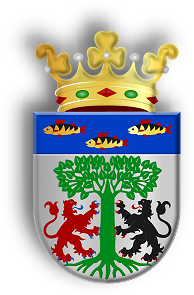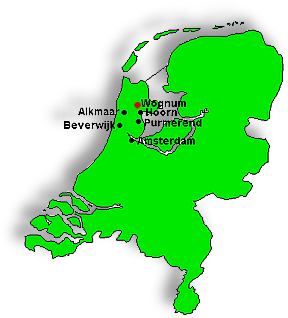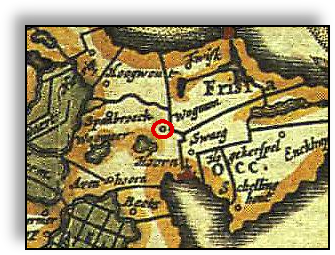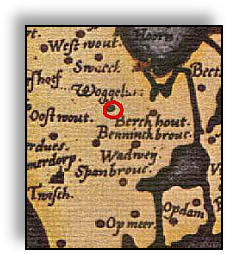
The coat of arms of the town of Wognum |
Het Wapen van Wognum2
In zilver een uitgerukte lindeboom van sinopel, ter rechterzijde gehouden door een leeuw van keel, getongd en genageld van azuur, ter linker door een leeuw van sabel, getongd en genageld van keel; in een schildhoofd van azuur 3 baarzen van goud, gestreept van sabel, gekieuwd, gevind en gestaart van keel, geplaatst 2 en 1. Het schild gedekt met een gouden kroon van 3 bladeren en 2 parels.
Wognum Civic Arms2
On a silver background, a green lime tree, held on the right by a red lion with nails and tongue of azure, on the left by a sable lion with nails and tongue of red; in a shield head of azure 3 gold bass with stripes of sable, gilled, tailed and finned in red, placed 2 and 1. The shield covered with a golden crown with 3 leaves and 2 pearls.
|
Archeological discoveries show that the history of Wognum began about 1700 BC. The first Bronze Age settlers made their homes between the Oude Gouw and the Kleine Zomerdijk. There may have been a settlement between A.C. de Graafweg and the Westeinderweg at the top of the Tramweg. A rise in sea level and the water table severely flooded the region, and habitation probably ceased sometime between 700 and 650 BC.

The town of Wognum is located in the Municipality of Wognum in
the West-Friesland region of North Holland in the Netherlands.
Then, for about 1000 years, the entire area of West-Friesland, including Wognum, was permanently flooded and became marshland. Almost all of the province of North Holland, where West-Friesland is located, is currently below sea level.The organic soil in the fens (Anglo Saxon: fen, fenn, marsh, mud, dirt) collected to a depth of two to three meters. During this period the Kromme Leek was one of the most important natural drainage streams.
Around 850 AD, Friesian people crossed the Zuider Zee to settle the Wognum area. About 1000 AD there was a small formal community bearing the family name Wog or Wok. The place name Wognum probably derives from this family name, with the addition of the suffix heim or hem, and ultimately um. The oldest recorded evidence for Wognum is Wokgunge, discovered in the archives of the Abbot of Echternach, in Luxembourg. Documents in the archives suggest that when Christianity was introduced around 1000 AD, a small chapel was built by the Wognum community. Thus it is that Wognum is probably the oldest inhabited area of the westerly region of West-Friesland, and consequently Wognum is the oldest village with the longest formally established church history.
The basis of the land division in West-Friesland was laid down in this period. Our forefathers must have done a fair bit of sploshing about in those fens, particularly at the time of the general draining away of the waters. The drainage of the fens led to their gradual disappearance.
Today there are only a few small areas within Wognum where fens such as Lekermeer survive. Our forefathers made desperate efforts to render the land suitable for farming through means of natural composting and the dredging of the land in the marshes. As a result there are still potholes throughout the countryside, as in the fields to the north of A. C. de Graafweg. These potholes were known as daliegaten, literaly dropholes.
Drainage caused more and more of the fens to disappear, resulting in the general lowering of the level of the land necessary to build dikes and windmills. Dikes such as Grote Zomerdijk, Kleine Zomerdijk and Oude Gouw were constructed. And Wognum came to appear more or less as we see of it today.

Wognum on a portion of Janssoniusí 1658 map of the
Netherlands. West Friesland is marked "Frisia Occ."3 |

A portion of a 1583 navigation chart by Lucas Jansz Aurigarius
shows Woggelum northwest of Hoorn. North is at the left.4
|
Old names for Wognum
Woggunghen (1063)
Wognem (1083, 1120)
Woggenom (1513)
Wognem (1544)
Woggenum (1544)
Wognum (1658) Janssonius, map of the Netherlands
Woggenum (1680) Jan Jansz Dou, polder map6
Woggelum (1583) Lucas Jansz Aurigarius, navigation chart
Undated:
Woggenem
Woggenhem
Woggingen
Woginghem
Wogginghem
Johannes Pannekeet5
Authorities in this field generally agree that the first part of the place name Wognum must be seen in connection with the Friesian man's name Wogen. Johannes (Jan) Pannekeet, an expert in Dutch and Friesian place names, writes that Wog(g)inghem is probably a combination of the family name Wog(g)ing, meaning Wogen and his offspring, and hem, meaning abode or residential area. Thus the meaning of the place name Wognum is "the place of residence of Wogen and his offspring".
_____
| 1. |
Almost all the text above is by me, Peter Wognum of the United Kingdom, collected with the help of a friendly clerk at the town hall of Wognum, North Holland in the Netherlands, in 1977. Additional material - and some welcome corrections - were provided by William Henry Roll prior to his inclusion of the material on his own genealogy web site which you can find here.
|
| 2. |
For the history behind the coat of arms of the town of Wognum go to International Civic Arms. The cleaner, and more colourful, version used at the top of this page, however, was found at the Wikipedia page for the town of Wognum.
|
| 3. |
You can view the complete Map of the Netherlands created by Jansonius in 1658 - a low resolution image of which is shown above, by clicking on it in the photo gallery section halfway down the page.
|
| 4. |
A navigation chart by Lucas Jansz Aurigarius (also called Lucas Jansz Waghenaer), dated 1583, is from an atlas named The Enchuyser Zeecaertboeck, with editions in 1598, 1601, and 1605. This map, clearly showing the town of Woggelum, was provided by Jan C. Van Woggelum.
|
| 5. |
Pannekeet, Jan. Westfries woordenboek. Wormerveer : Stichting Uitgeverij Noord-Holland, 1984. 420 p. 21 cm. ISBN: 9071123014. Note: An analysis of Dutch and Frisian words and place names.
|
| 6. |
Dou, Jan Jansz. Kaart van het Hoogheemraadschap van de Uitwaterende Sluizen van Kennemerland en West-Friesland, eenbladskaart uit ca. 1680. Bibliotheek van de Universiteit van Amsterdam.
|
|